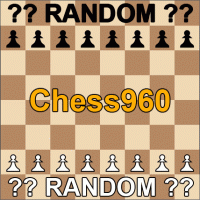
Chess960: The Opening Makes a Comeback!
I'm definitely a candidate for "most excited that chess.com added chess960." I remember when I first joined the team in January, Erik and Jay asked what ideas I had about the future development of chess and chess.com. I told them that in my opinion opening theory was choking the game, and Fischer Random (or something similar) was the future of the game. [I have a terrible memory, so I'm basically making up this scene for dramatic effect] Erik looked at me with a very serious, interested face: "are you serious?" while Jay just groaned loudly. Basically, chess960 had occurred to them before as a feature they'd like, but it was going to be a hellishly involved project for Jay, so it was not near the top of the list. But I think I had some influence on them there, and they decided this really was an important feature.
So at some point (this part is easy for everyone but him to gloss over), Jay rolled up his sleeves and worked really hard on this, and then ta-da before I knew it, they were talking about releasing it in a couple days, and it was my turn, to turn an incredulous look back and forth between them and ask "seriously??" When I'd ascertained they were serious, I was very happy. A few days later, chess960 was released and I wanted to get the inaugural game in. I'm sure I did not actually get it, but I did get a game really fast. I went into the thread on new features, and posted that I was looking for a game; by the time I clicked back to my homepage, a challenge was awaiting me.
Awesome!!
Now, for all my enthusiasm, I'm no great expert on random. But I have a few ideas about how to play the opening, and I'll now publish [probably chess.com's inaugural] article on the subject. If you are a complete novice, this should hopefully be of some use.
Getting out of the car the other day, Jay asked me if there were any particular things I looked for in the random starting positions. Unfortunately, there is not, so I can't give you any advice about the first move.
The first thing I generally check for are bishops or queens on h1/a1. Queens are often terrible on a1/h1 Think about their ideal placement in many openings, e2/d2 from whence they can support action in any direction, and quickly transfer. a1/h1 is about as far away as they can be, because you either have to clear your first rank of pieces and then transfer them along the first rank (often impeded by rooks which seldom leave the first rank) or you have to clear the second rank of pawns, which also takes a lot of moves, and can to boot leave you with myriad weaknesses. But in chess960, you'll fairly often find someone leaving their queen on a1/h1 for a while, because it's inconvenient to improve her-- and then regretting it later when the game opens and they find themselves hopelessly lacking in coordination and power. Yes, the queen is very important!! And we often forget how big an impact she has because she doesn't usually end up on such a bad square.
Here are other first move considerations:
- Is any pawn undefended in the starting position? This will often play an important tactical role in the first few moves. Remember the importance of the f2/f7 squares in e-pawn openings? Imagine: each new position you see may have its own magic square like that, with varying importance on the play. Sometimes there is an undefended pawn, which, if captured by a knight, would be a smothered mate. So I almost always check for this second.
- Does one side of the board have both knights or both bishops? Can you imagine why I ask myself this question? This question is unique to random and has no analogy in normal chess where kside and qside each have one bishop and one knight. Here's the importance of this question: knights are not particularly fast/good at transferring from one wing to the other. If your king is on the opposite wing from both your opponent's knights, they won't be bothering him any time soon. Bishops can adjust more quickly, but it should also be noted that they naturally fire at the opposite side of the board. So if you castle to the opposite side, where the bishops will already be raking your king's defenders, you are saving them some trouble.
In the standard chess position, castling kingside or queenside is largely a matter of expediency, plus a question of "do you want to be on the same side or opposite side of your opponent's king." In a lot of random positions, there is a clearly preferable side of the board for the king to be on, and I'm willing to go through some amount of contortions to make that happen. Thus this is a very important question to ask at the beginning, as I figure out in what order I want to develop.
- How easily are the squares e4, d4 attacked/defended? And by what? Think to the standard position. d4 is more easily controlled by white than e4. Thus: if you play d4, black will have less counterattacks against your central position, but you will have a harder time following up with e4 if you want to try to take over the whole board. Comparatively if you play e4, it is quite easy to follow up with d4 in essentially every opening, however, your e4 point is more vulnerable to counterattack. This, as far as I know, is the basis of the sharper nature of most e4 openings compared to d4 openings over the first 8-10 moves.
So, just as in the standard position, you'd like to start by taking over the center (this is chess after all!). So quickly consider e4 and d4. If I play e4, how can he counterattack this pawn, and how easily could i follow with d4 (or f4)? Same questions for d4. Another important point is, how will he attack the pawn? Imagine bishops on h1, a1, h8, a8. In these positions it is often dangerous to play e4 OR d4, because imagine 1.e4 b6 attacking your e4 pawn, 2.g3 defending the pawn. but now if Bh1 is undefended, your e4 pawn can no longer move, and black is free to play moves like f5. I've seen white worse within 2-3 moves in some such cases!
- Finally, just as in the standard position, I try to look for moves that will "force" or "encourage," a weaker response from the opponent. (like 2.Nf3 after e4 e5 in standard chess).
Here are the first ten moves of my first chess960 game on chess.com, with some commentary that should give some idea of how I approach concrete questions in the opening.
I hope you, too, will enjoy chess960. Here are two links to help you get started:
To start a 960 game, go here: http://www.chess.com/echess/create_game.html and under Advanced Options choose Type: Chess960.
For more info, read here: http://en.wikipedia.org/wiki/Chess960

